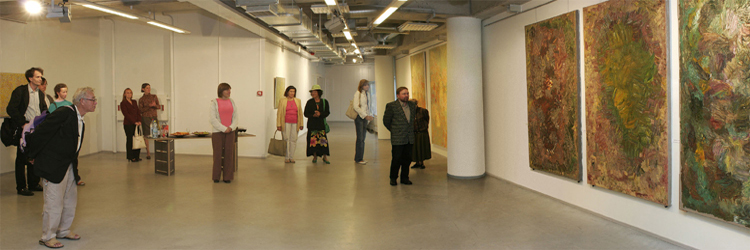Chronicle
/.../ Ove Büttner (1959) has recently stepped into artistic life with his specific artistic style - he has an utterly delicate relationship towards the world and art that is expressed in the bright sunny colouring of large-size paintings, where peace and solemnity seem to prevail. On his canvases, colours take the leading role; they turn smoothly and disappear into one another, forming surmising figures that are either barely recognisable signs of life or abstract blotches. By the end of 1980s, when Ove Büttner gave the first signs of himself on exhibitions (the debut at the Exhibition of Young Artists in 1986, participation in the Exhibitions of Young Artists in 1987 and 1988, the exhibition of the Group T on the premises under the Tallinn Song Festival Dais in 1988, the diploma of a painter from Tallinn Art University in 1989), the time seemed to favour directly opposite kind of art, because vigorous, American-like effective or German-like expressive styles dominated at exhibitions. Perhaps Ove Büttner has fascinated the public namely due to the merging contrast? From the beginning, he has been independent, unrelatable to his contemporaries, not reducible to the grand masters in art history. In his case, French sophisticated culture of colours could be spoken of, but he nevertheless depicts Estonia. Ove Büttner's first comprehensive personal exhibition in Tallinn Art Hall Gallery in November 1991 provided an opportunity to observe the so-far development of the artist from his earliest work "Painting Madonna" up to his vast canvases, related to each other to the extent of fusion, that were treated above ("Golden Hill", "Arearea"). A novel and surprising in his case, Ove Büttner has inserted a conflict into his latest works - again in the form of colours! He is experimenting with a painting technique, converse to the one he has used up to the present, side-by-side imprinting contrast dots of paint (directly from the tube?), not asking whether the result is harmonic or not (an important category in his so-far creation). As if bright metropolitan lights ("Paris"), sharpening all the senses ("Summer"), had cut into the calm dreaminess of works. Such a transformation was a little strange for Ove Büttner, except for an excellent portrait "Elo" - a synthesis of harmonic and disharmonic styles. Perhaps the train of thought will continue to develop in this direction, but we can only guess this. /.../
